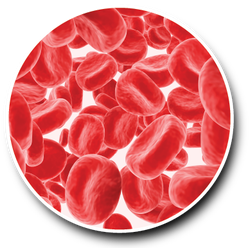Biologics
Repairing Joint Damage Non-Surgically
Regenerative therapies treat osteoarthritis instead of surgery. 
An active lifestyle and longer life span are driving more people to seek care for their damaged joints. While joint replacements in the knee, hip and shoulder can remedy the pain often caused by arthritis, some are opting for biologic therapies, sometimes called regenerative medicine.
Minimally invasive, cutting-edge therapies known as “biologics” can now replace the scalpel in some cases— and the months of rehab that follow.
Orthopedic Surgeon Peter Bonutti, MD, FACS, oversees the Biologics Center at the Sarah Bush Lincoln Bonutti Clinic in Effingham, where his love of science and his desire to ease his patients’ pains fuels his passion for research and development. Internist Louis Schwing, MD, who oversees Occupational Medicine at the clinic, has an increasing number of people requesting the minimally invasive and non-invasive treatments.
The SBL Bonutti Clinic in Effingham and SBL Orthopedics & Sports Medicine in Mattoon offer this cutting-edge treatment. The goal of the treatment is to restore patients’ natural joint surfaces (rather than to replace them with metal and plastic), so patients enjoy higher functioning and more normal activity. Biologic resurfacing is a spectrum of interventions that helps to heal diseased joints.
Biologic resurfacing can enhance the body’s natural ability to heal, reduce inflammation in arthritic joints, and accelerate the repair of damaged tendons and ligaments. Cartilage that is worn, torn or cracked can heal. “The challenge is discovering these deficiencies early enough to make a lasting impact. Our goal is cartilage restoration,” Dr. Schwing said, “rather than cartilage replacement.”
In the early stages of joint deterioration, the physicians can:
- Inject joint lubricant (called hyaluronic acid)
- Inject into the joint blood platelets concentrated with enzyme cofactors to speed healing.
 In addition to biologic resurfacing, the physicians provide platelet therapy (platelet-rich plasma or PRP) and provides stem cell therapy (undifferentiated cells to replace injured cells), which is a modality that’s been used for decades to speed tissue and cartilage healing by using the nutrients in patients’ own blood supplies. It works by pulling platelets out of a patient’s blood, concentrating them and then injecting the platelets into the affected joint to decrease pain and inflammation.
In addition to biologic resurfacing, the physicians provide platelet therapy (platelet-rich plasma or PRP) and provides stem cell therapy (undifferentiated cells to replace injured cells), which is a modality that’s been used for decades to speed tissue and cartilage healing by using the nutrients in patients’ own blood supplies. It works by pulling platelets out of a patient’s blood, concentrating them and then injecting the platelets into the affected joint to decrease pain and inflammation.
At SBL Orthopedics & Sports Medicine in Mattoon, Eric Brewer, DO, uses biologic treatments for arthritic joints as well as tendon and muscle injuries, providing a faster recovery. “These injections can be repeated as often as possible depending on which joint, muscle or tendon is injured,” Dr. Brewer said. He has seen great results using biologics for treating athletic injuries such as tendon and rotator cuff injuries, or painful tissues that have not responded to steroid injections. “They are an excellent option for patients that are not candidates for steroids or other anti-inflammatories,” Dr. Brewer explained.
Biologic therapy uses substances made from living organisms to treat disease including orthopedics. (Biologics is not yet covered by insurance since many insurance plans are still gathering data, but patients who are looking for new approaches to healing may want to pursue biologics anyway.)
Dr. Bonutti said, “Depending on the severity of the disease, if it’s early, you may be able to potentially slow disease progress, decrease pain, and improve activity. In more advanced disease, it may be a more temporizing procedure. But if you can gain people months or years of life out of their existing joint, that adds substantial value.”
For more information about Biologics, call the SBL Bonutti Clinic in Effingham at 217 342-3400 or for SBL Orthopedics & Sports Medicine in Mattoon call 217 238-3435.
